THE SOUTHWORTH PLANETARIUM
70 Falmouth Street Portland, Maine 04103
(207) 780-4249 usm.maine.edu/planet
43.6667° N 70.2667° W
Altitude: 10 feet below sea level
Founded January 1970
2021-2022: CVIII
“The most beautiful experience we can have is the mysterious. It is the fundamental emotion that stands at the cradle of true art and true science.” -Albert Einstein
THE DAILY ASTRONOMER
Monday, April 11, 2022
Solar Eclipse Series # 2: The Basics of Solar Eclipses
_______________________
728 days until the April 8, 2024 solar eclipse.
_______________________
_______________________
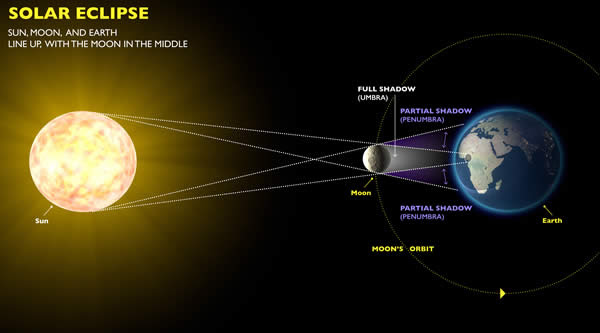
Solar eclipses are simple in concept, yet complicated in application. They occur when the moon moves directly in front of the Sun from Earth's perspective. A solar eclipse can only occur when the moon is at conjunction (new moon) and is at or near a node, the intersection point connecting Earth's orbit and the moon's. Solar eclipses don't occur every month because the moon's orbit is inclined to Earth's orbital plane by slightly more than five degrees. Generally when the moon is new, it will be north or south of this plane and no eclipse will occur.
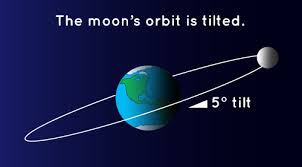
If the moon's orbit were precisely aligned with Earth's orbit, eclipses would be monthly occurrences.
We recognize four basic solar eclipse types:
- TOTAL: when the moon completely covers the Sun
- ANNULAR: when the moon moves directly across the Sun, but appears smaller than the Sun. At totality, the moon is surrounded by a ring of sunlight.
- PARTIAL: when the moon only partially covers the Sun
- HYBRID: when the eclipse is annular and total during the same eclipse.
Our focus for this series is, of course, the total solar eclipse on April 8, 2024. It will be the first total solar eclipse visible in Maine since 1963. (The next total solar eclipse visible in Maine occurs on May 1, 2079.) The map below pertains to the April 8, 2024 eclipse
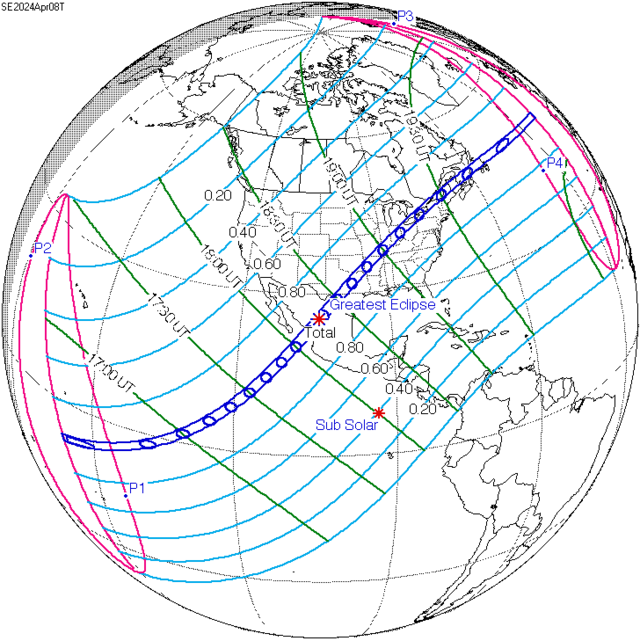
Any observer within the region under the blue grid will be able to observe the eclipse. What the observer actually sees will depend on his/her location. Anyone within the dark blue arc extending from the Pacific to the north Atlantic will see a total solar eclipse. That blue arc defines the totality path, the only place where the eclipse appears total. We can see that western and northern Maine are within the totality path. The Portland area will not be. Observers outside this arc will see a partial solar eclipse, the magnitude of which depends on the observer's distance from the path. For instance, an observer standing somewhere along the 0.8 line (running through Mexico, Alabama, Georgia, South Carolina and North Carolina) would see an eclipse of magnitude 0.8, meaning that the moon will cover 80% of the Sun's diameter. As another example, an observer along the 0.2 line (perhaps British Columbia or Costa Rica) would see the moon cover only 20% of the Sun's diameter. Any observer north of the top blue line or south of the bottom blue line won't see any part of the eclipse at all.
- The totality path is within the umbra, the darkest part of the moon's shadow
- The other regions in which only partial eclipse will be visible is within the penumbra, the outer part of the moon's shadow.
[Important note: Magnitude is NOT the same as Obscuration. Magnitude measures how much of the Sun's diameter the moon covers. Obscuration measures the amount of the solar disk the moon covers. Example, if the eclipse magnitude is 0.5, the obscuration is about 39.1%.

We can see that when the moon covers half the Sun's diameter more than half of the Sun remains visible.]
THE APPEARANCE:
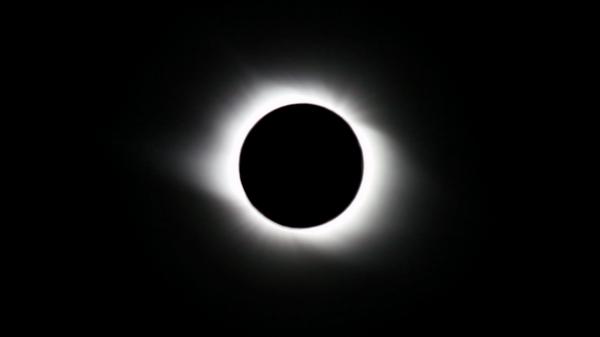
During a total solar eclipse, the moon completely covers the Sun. During totality the corona, the outermost part of the Sun's atmosphere, becomes visible. The sky darkens enough to render the stars visible.
 Safety note: While eclipse glasses are certainly necessary to safely watch the eclipse prior to and after totality, one may safely observe the Sun during totality PROVIDED that one looks away before totality ends. Be sure not to look at the Sun without protection when totality ends. Even the sunlight emitted by the thin crescent that emerges just after totality can damage your eyes.
Safety note: While eclipse glasses are certainly necessary to safely watch the eclipse prior to and after totality, one may safely observe the Sun during totality PROVIDED that one looks away before totality ends. Be sure not to look at the Sun without protection when totality ends. Even the sunlight emitted by the thin crescent that emerges just after totality can damage your eyes. THE FREQUENCY
At least four eclipses will occur each year. On rare occasions as many as seven eclipses occur in a year. During minimum years (only four eclipses), two will always be solar eclipses and the other two lunar eclipses (the passage of the moon through Earth's shadow.) A solar eclipse and a lunar eclipse will be separated by two weeks because each eclipse type happens when the moon is at or near a node. Earth's orbit and that of the moon are connected by two nodes separated by 180 degrees, the same separation distance between new moon and full moon (the moon phase during a lunar eclipse.)
THE SAROS CYCLE
We can predict eclipses because of the Saros Cycle. An eclipse with the same geometry will repeat every 18 years, 11 days and 8 hours. We know that a solar eclipse can only occur when the moon is new and at or near a node. However, an eclipse can occur at any point in the moon's orbit. Sometimes eclipses will occur when the moon is at or near perigee (the point of least distance) or at apogee (the point of greatest distance) or somewhere in between.
We can predict eclipses because of the Saros Cycle. An eclipse with the same geometry will repeat every 18 years, 11 days and 8 hours. We know that a solar eclipse can only occur when the moon is new and at or near a node. However, an eclipse can occur at any point in the moon's orbit. Sometimes eclipses will occur when the moon is at or near perigee (the point of least distance) or at apogee (the point of greatest distance) or somewhere in between.
Eclipses within the same saros cycle will occur 18 years, 11 days and 8 hours apart and at approximately the same distances. This time period corresponds to:
- 223 synodic months (a synodic month equal to the time period separating successive new moons. Approximately 29.5 days)
- 242 draconic months (a draconic month is equal to the time period the moon requires to return to the same node. Approximately 27.2 days)
- 239 anomalistic months (an anomalistic month is the time period separating successive perigees. Approximately 27.5 days.)
The April 8, 2024 solar eclipse is part of Saros cycle 139. The first eclipse in this cycle was a partial solar eclipse that occurred on May 17, 1501. The last eclipse will be another partial, scheduled for July 3, 2763. The eclipse prior to the April 8, 2024 event occurred on March 29, 2006. The one after will happen on April 20, 2042.
Based on this Saros cycle, can you predict when the next one will occur?
Answer: April 30, 2060
EXELIGMOS
Note that the period of a Saros cycle is 18 years, 11 days and 8 hours. As eight hours equals one third of a day, an eclipse in a given Saros Cycle will be displaced by about 120 degrees relative to the previous eclipse. However, every third eclipse within the same Saros will be visible within the same general area. Or, every eclipse separated by 54 years and 33 days will have similar geometries and will be seen in the same part of the world. However, their respective totality paths will be displaced. We call this 54 year 33 day time period as one "exeligmos," from the Greek for "turning of the wheel"
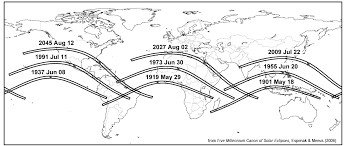
The above image shows the totality paths for nine successive eclipses within Saros Cycle 136. We see that each eclipse within this saros is displaced by about 120 degrees relative to the one prior and the one following. However, every third eclipse happens along the same part of the planet. Notice that the June 8 1937 eclipse is south of the July 11 1991 eclipse which is south of the August 12 2045 eclipse. Each of these eclipses are separated by one Exeligmos.
Throughout the next year, we will be exploring each of these aspects and many others in far greater detail. In Solar Eclipses # 3, we'll delve more deeply into the totality path and partial eclipse region map.
To subscribe or unsubscribe from the Daily Astronomer: